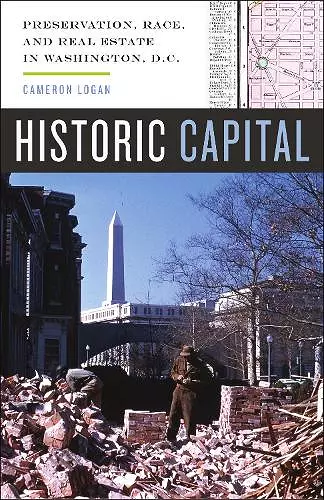Historic Capital
Preservation, Race, and Real Estate in Washington, D.C.
Format:Paperback
Publisher:University of Minnesota Press
Published:19th Dec '17
Currently unavailable, and unfortunately no date known when it will be back

Washington, D.C. has long been known as a frustrating and sometimes confusing city for its residents to call home. The monumental core of federal office buildings, museums, and the National Mall dominates the city’s surrounding neighborhoods and urban fabric. For much of the postwar era, Washingtonians battled to make the city their own, fighting the federal government over the basic question of home rule, the right of the city’s residents to govern their local affairs.
In Historic Capital, urban historian Cameron Logan examines how the historic preservation movement played an integral role in Washingtonians’ claiming the city as their own. Going back to the earliest days of the local historic preservation movement in the 1920s, Logan shows how Washington, D.C.’s historic buildings and neighborhoods have been a site of contestation between local interests and the expansion of the federal government’s footprint. He carefully analyzes the long history of fights over the right to name and define historic districts in Georgetown, Dupont Circle, and Capitol Hill and documents a series of high-profile conflicts surrounding the fate of Lafayette Square, Rhodes Tavern, and Capitol Park, SW before discussing D.C. today.
Diving deep into the racial fault lines of D.C., Historic Capital also explores how the historic preservation movement affected poor and African American residents in Anacostia and the U Street and Shaw neighborhoods and changed the social and cultural fabric of the nation’s capital. Broadening his inquiry to the United States as a whole, Logan ultimately makes the provocative and compelling case that historic preservation has had as great an impact on the physical fabric of U.S. cities as any other private or public sector initiative in the twentieth century.
"Cameron Logan presents a clear, convincing thesis—that historic preservation was a driver of urban development, politics and culture, not an afterthought or a sideline. His account is compelling and rich; it will appeal to urbanists, historians and preservationists alike. Critically, the history of preservation is framed not as an insular matter or a progressive narrative of preservationist victories. He rightly presents preservation as part of the mix of urban movements (in urban design, poverty alleviation, community organizing, economic development) competing for political attention."—Randall Mason, University of Pennsylvania
"Logan’s powerful and provocative work lays a strong foundation for future scholarship that may follow the tantalizing traces he has uncovered."—Journal of American Ethnic History
"Logan’s book adds to the growing literature on the history of Washington, D.C. While Washington is often considered an anomaly in the realms of urban studies, architectural history, and historic preservation, Historic Capital and its contemporaries continue to prove that the nation’s capital is not just a destination worthy of a Fourth of July visit. They show that it is instead a true urban center deserving of rigorous analytical research that connects to these various fields, so that one day the case studies outline herein will be a familiar part of the history of historic preservation, urban planning, and real estate."—Buildings & Landscapes
ISBN: 9780816692347
Dimensions: 216mm x 140mm x 38mm
Weight: unknown
304 pages